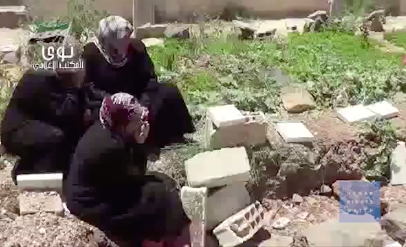
Still from a video produced by Human Rights Watch on the aftermath of a barrel bomb attack © Human Rights Watch
With international concern at the death, injury and devastation caused to civilians by barrel bombs in Syria consistent and pressing, this policy note from INEW situates barrel bombs within the urgent, global humanitarian problem of the use of explosive weapons in populated areas, particularly those that affect wide areas, which must be addressed by states.
As part of a broader pattern of conflict parties’ use of explosive weapons with wide area effects in populated areas, barrel bombs have caused catastrophic harm to civilians living through the conflict in Syria.
Barrel bombs are improvised explosive devices dropped from aircraft, often helicopters.
Download this policy note as a PDF.
INEW policy on barrel bombs
September 2015
- Barrel bomb attacks in Syria are one prominent example of the wider problem of civilian harm caused by the use of explosive weapons in populated areas.
- International condemnation of barrel bomb attacks reflects the general stigma attached to bombing and bombardment in towns and cities.
- Whether barrel bombs in Syria, rockets in Ukraine, or aircraft bombs in South Sudan or Yemen, when such weapons are used in populated areas, the great majority of direct victims are civilians. In addition, longer-term and indirect harm affects communities for years afterwards.
- Barrel bombs come in different shapes and sizes. As they tend to contain a large amount of explosive material, and due to the difficulty of delivering them accurately to a target, barrel bombs tend to have wide area effects.
- Like other explosive weapons with wide area effects, such as heavy artillery shells, rockets and aircraft bombs, their use in populated areas is unacceptable.
- In addition, as they are improvised weapons, the effects of any particular barrel bomb are very hard to foresee, making it impossible to adequately assess the risk of harm to civilians and prevent that harm.
- Data on the casualties from barrel bombs in Syria is difficult to gather, not least because it is not always straightforward to identify the weapon used in a particular attack. It can be hard to disaggregate this data by type of explosive weapon, but data collected indicates that, globally, around 90% of casualties from the use of explosive weapons in populated areas are civilians.
- Barrel bombs have recently come to prominence in the context of Syria (and to a lesser extent Iraq); their use is not widespread in conflicts around the world. The broader problem of explosive weapon use in populated areas though is global in scale, with over 50 countries affected.
